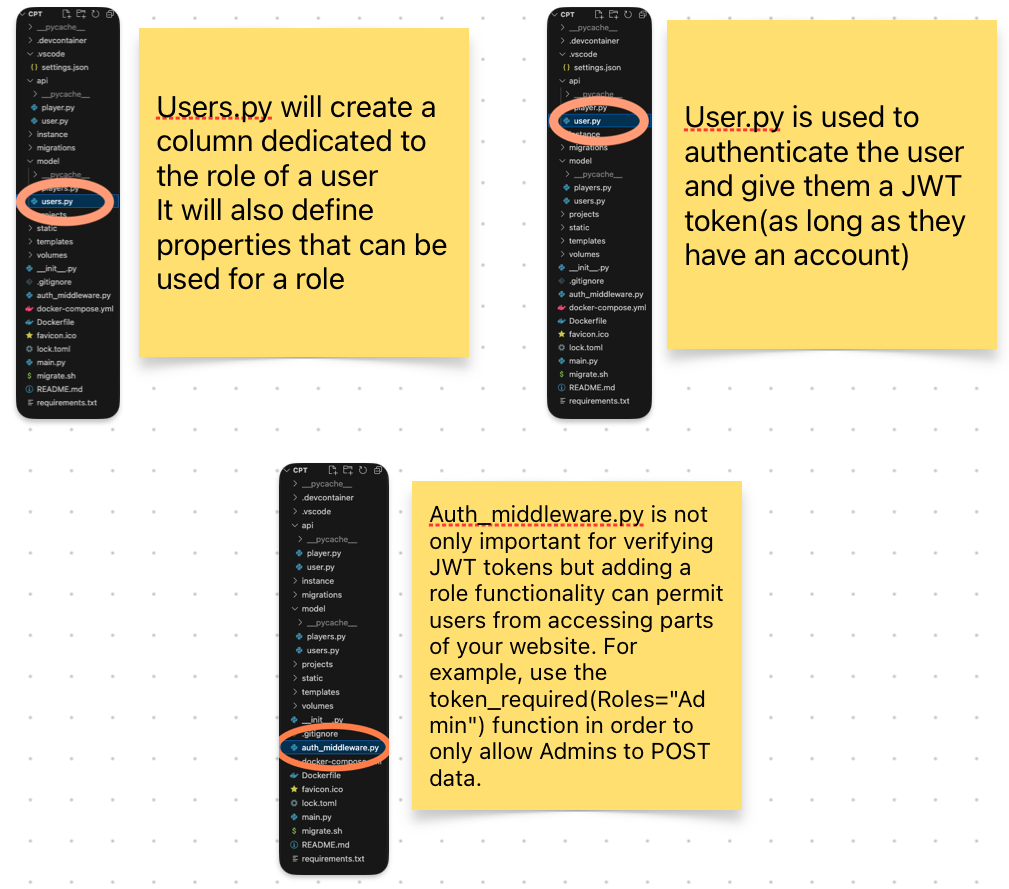Flask JWT Roles for User / Admin user
Goal
-
This team teach will show you how to add roles to users when they create their account
- Roles are like Google Doc sharing permissions: you can give someone Viewer, Commenter, or Editor permissions
-
Roles can be used in your code to restrict access to certain actions and pages
- If you want to follow along, go to the users.py file of your cpt project that you cloned.
class User(db.Model):
# ... (existing code)
#-------------------------------------------------------------------------------------------------------------------------------------------------#
# Goes into your users.py file. This will create a column dedicated for roles
_role = db.Column(db.String(20), default="User", nullable=False)
#-------------------------------------------------------------------------------------------------------------------------------------------------#
def __init__(self, name, uid, password="123qwerty", dob=date.today(), role="User"):
# ... (existing code)
self._role = role
#-------------------------------------------------------------------------------------------------------------------------------------------------#
# With this property, you can access the user's role using user_instance.role instead of user_instance._role.
@property
def role(self):
return self._role
#-------------------------------------------------------------------------------------------------------------------------------------------------#
#-------------------------------------------------------------------------------------------------------------------------------------------------#
# With this setter, you can update the user's role using the assignment syntax: user_instance.role = "NewRole".
@role.setter
def role(self, role):
self._role = role
#-------------------------------------------------------------------------------------------------------------------------------------------------#
#-------------------------------------------------------------------------------------------------------------------------------------------------#
# This method returns True if the user's role is "Admin" and False otherwise.
def is_admin(self):
return self._role == "Admin"
#-------------------------------------------------------------------------------------------------------------------------------------------------#
# ... (existing code)
# CRUD read converts self to dictionary
# returns dictionary
def read(self):
return {
"id": self.id,
"name": self.name,
"uid": self.uid,
"dob": self.dob,
"age": self.age,
#-------------------------------------------------------------------------------------------------------------------------------------------------#
# When you GET/read the endpoint, it will also return the user's role
"role": self.role,
#-------------------------------------------------------------------------------------------------------------------------------------------------#
"posts": [post.read() for post in self.posts]
}
Popcorn Hack 1: What is the function of CRUD read (Check comments)? Answer:
def initUsers():
with app.app_context():
"""Create database and tables"""
db.create_all()
"""Tester data for table"""
#-------------------------------------------------------------------------------------------------------------------------------------------------#
# When you create the test users for the database, you can add a role for them. In this case, Thomas Edison has the role "Admin"
u1 = User(name='Thomas Edison', uid='toby', password='123toby', dob=date(1847, 2, 11), role="Admin")
#-------------------------------------------------------------------------------------------------------------------------------------------------#
# ... (existing code)
- This file is user.py(not users.py which was the file above) of your cpt project that you cloned.
class _Security(Resource):
def post(self):
try:
body = request.get_json()
if not body:
return {
"message": "Please provide user details", #After attempting to retrieve JSON data, this block checks if the body is empty or None.
#If there's no JSON data in the request, the function returns a JSON response indicating that the user should provide user details, along with a status code of 400 (Bad Request).
#This is a common practice to handle cases where the expected data is missing or improperly formatted.
"data": None,
"error": "Bad request"
}, 400
''' Get Data '''
uid = body.get('uid') #checks for UID
if uid is None:
return {'message': f'User ID is missing'}, 400
password = body.get('password') #checks and looks if possible password is there.
''' Find user '''
user = User.query.filter_by(_uid=uid).first()
if user is None or not user.is_password(password):
return {'message': f"Invalid user id or password"}, 400
if user:
try:
#-------------------------------------------------------------------------------------------------------------------------------------------------#
# The only change you're making is that you include the user's role when they get authenticated
token_payload = {
"_uid": user._uid,
"role": user.role # Add the role information to the token
}
#-------------------------------------------------------------------------------------------------------------------------------------------------#
token = jwt.encode(
token_payload,
current_app.config["SECRET_KEY"],
algorithm="HS256"
)
# ... (existing code)
- This file is auth_middleware.py of your cpt project that you cloned.
from functools import wraps
import jwt
from flask import request, abort
from flask import current_app
from model.users import User
#-------------------------------------------------------------------------------------------------------------------------------------------------#
# Whenver you call this function in your code, you can add an argument like Roles="Admin" to only allow admins to access a certan part.
def token_required(roles=None):
#-------------------------------------------------------------------------------------------------------------------------------------------------#
def decorator(f):
@wraps(f)
def decorated(*args, **kwargs):
token = request.cookies.get("jwt")
if not token:
return {
"message": "Authentication Token is missing!",
"data": None,
"error": "Unauthorized"
}, 401
try:
data = jwt.decode(token, current_app.config["SECRET_KEY"], algorithms=["HS256"])
current_user = User.query.filter_by(_uid=data["_uid"]).first()
if current_user is None:
return {
"message": "Invalid Authentication token!",
"data": None,
"error": "Unauthorized"
}, 401
#-------------------------------------------------------------------------------------------------------------------------------------------------#
# Check if roles are provided and user has the required role
if roles and current_user.role not in roles:
return {
"message": "Insufficient permissions. Required roles: {}".format(roles),
"data": None,
"error": "Forbidden"
}, 403
#-------------------------------------------------------------------------------------------------------------------------------------------------#
except Exception as e:
return {
"message": "Something went wrong",
"data": None,
"error": str(e)
}, 500
return f(current_user, *args, **kwargs)
return decorated
return decorator
Popcorn Hack 2: What is the purpose of “def token_required(roles=None):” ? Answer:
- Here’s aFreeform Diagram to help you better understand each file
